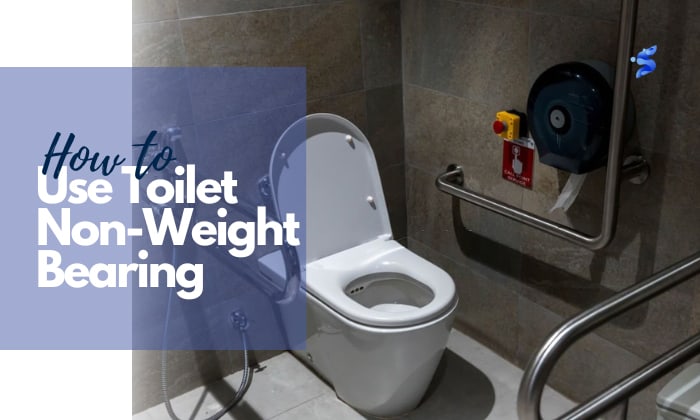It’s difficult to move around when you’re non-weight bearing after foot surgery. You have to hop with your good leg and prevent the injured leg from touching the floor. So, how to use toilet non weight bearing style?
You’ll need the right equipment to help you walk, like crutches or a walking frame. Use your arms to help you descend to the toilet seat while keeping your injured leg securely braced. Make sure to keep the weight off the wounded foot by elevating it while sitting in the commode.
Let’s check each possible mobility device that can help you use the toilet while being in a non-weight-bearing state.
Table of Contents
What to Prepare
- Walking aid like crutches or walking frame
- Toilet frame or raised toilet seat
Step-by-step Instructions
Here are the following mobility devices you can use to be independent when you’re recovering from a non-weight bearing leg.
Method 1: Using a Set of Crutches
The basic walking aid that your physical therapist can recommend is a pair of crutches. This walking aid is perfect for people with strong upper bodies and without any balance issues. Here’s how to toilet transfer with crutches.
- First, adjust the height of the crutches. The top of the crutches shouldn’t be touching your armpit. Leave a 2-3 fingers gap in between and ensure that you’re holding the handle with elbows slightly bent.
In addition, the crutch’s tip should be 6 inches away from the side of your feet. - Next, stand upright and walk by moving the bottom tips of the crutches forward into the bathroom. Move the injured leg with your body as you walk to keep your balance.
- As you reach the toilet, stand with your back facing it. Put the two crutches in one hand (preferably the side without the injured foot) and slowly grab the toilet frame handle in another hand to get into the sitting position. If you have no toilet frame, lean on the nearest wall for support.
- Bend your good leg and elevate your injured leg while sitting.
- After doing your business, push yourself a bit forward off the commode. Put the two crutches in one hand and hold the wall or frame in another hand to stand with your good leg. Move the crutch at each hand and walk away.
Method 2: Using a Walking Frame
If you’re suffering from balance problems or weakness prior to the injury, then a walker suits you better. Most of the weight goes to your arms, hence providing more stability than crutches. Also, it moves faster, thanks to the wheels attached to the front.
- First, stand upright with your good leg and put your hands on the walker.
- Now, roll the walker forward and step forward with your unaffected leg. Make sure that you don’t move the walker too far, or you’ll strain yourself.
- Position yourself on the toilet with the back of your good leg touching the seat and the injured leg extended forward.
- Slowly descend yourself with one hand holding the walker and another holding the edge of the seat.
- To get off the toilet, scoot to the seat’s edge, then push yourself up with one hand from the seat and the other holding the walker.
Method 3: Other Toilet Transfer Techniques
Besides the traditional crutches and walking frames, you can choose many other mobility equipment to help you use the toilet. Here are a few recommendations.
- Wheelchair: If you’re too weak to use your good leg, then you’ll probably need more help with this equipment. Choose a chair with an elevated footrest to brace the injured leg better. Also, ensure you have enough space in your bathroom to move around and an extra hand to help you transfer.
To transfer yourself to the toilet, use one hand to grasp the wheelchair’s frame and the other to grip its wheel. Scoot to the edge of the wheelchair and place your good foot on the ground. Lean your hand on the toilet seat and get on the commode.
- Knee Walkers: This nifty is another perfect way to help your non-weight bearing transfer to the toilet. It looks like a scooter but with a support platform above to rest your knee. With four wheels attached, balancing is easy.
Position yourself so that your good leg is by the side of the toilet. Lower your body and lean on the toilet seat with your hand. Then, slowly maneuver your body until you’re comfortably seated on the commode. Again, your injured foot should be off the ground.
Conclusion
Now you know how to use toilet non-weight bearing style. All the walking aids above are effective, but my favorite is the walking frame because it’s more stable and easier to use. If you have strong balancing skills, a pair of crutches will suffice.
Let us know your favorite non-weight-bearing walking aids in the comment section below. To spread this useful information, please share the article with your friends.

I’m Paulk Webb, and I work as a writer for Saveourwaterrebates. I’m happy to put in the time and effort to conduct market research to identify the most pressing issues faced by households concerning their plumbing. Feel free to check out our guides to get the most informed recommendations for how to solve your problems.





